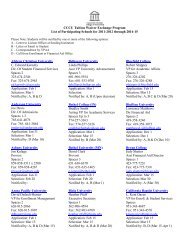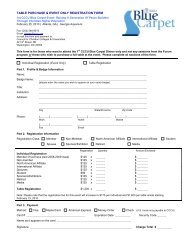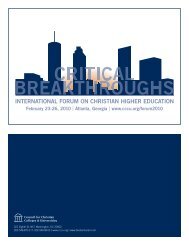Psychoanalysis, Attachment, and Spirituality Part II ... - Dr. Todd Hall
Psychoanalysis, Attachment, and Spirituality Part II ... - Dr. Todd Hall
Psychoanalysis, Attachment, and Spirituality Part II ... - Dr. Todd Hall
Create successful ePaper yourself
Turn your PDF publications into a flip-book with our unique Google optimized e-Paper software.
30 PSYCHOANALYSIS, ATTACHMENT, AND SPIRITUALITY PART <strong>II</strong><br />
Mitchell made a cogent case that under the surface<br />
of the varied relational theories, a broad relational<br />
model exists.<br />
Notwithst<strong>and</strong>ing this broad relational model,<br />
many different relational theories continued to<br />
abound, often times claiming comprehensive status,<br />
even though they typically emphasized a narrow slice<br />
of personality (Mitchell, 1988). In a later work,<br />
Relational Concepts in Psychoanalysis, Mitchell<br />
(1988) presented an integrative relational theory, further<br />
articulating his version of this broad relational<br />
model. In this work, Mitchell argues that the field<br />
has suffered from theorists following in the shadow<br />
of Freud by attempting to develop the next gr<strong>and</strong><br />
psychoanalytic theory, <strong>and</strong> in the process ignoring or<br />
discounting compatible relational theories. Mitchell<br />
argued, in contrast, that the varied relational theories<br />
are in fact complimentary, <strong>and</strong> that the way forward<br />
involves synthesizing complimentary aspects of a<br />
relational matrix that includes dimensions of the<br />
self, the other, <strong>and</strong> the space between them. Some<br />
theories emphasize the self, others emphasize internal<br />
representations of the other, <strong>and</strong> yet other theories<br />
emphasize the space between. Despite their differing<br />
emphases, they each comprise parts of an<br />
integrated relational matrix.<br />
In his cogent attempt to synthesize relational theories,<br />
Mitchell developed a relational-conflict<br />
model. He argues that in retiring Freud’s drive theory,<br />
we need not ab<strong>and</strong>on core aspects of human experience<br />
such as sexuality, narcissism, infantile desires,<br />
conflict, <strong>and</strong> illusion. Moreover, we need not choose<br />
between the self, internalizations of others, <strong>and</strong> interpersonal<br />
transactions. Rather, each of these major<br />
facets of human experience is reinterpreted in a radically<br />
different light—that of the relational matrix.<br />
Development is not constituted by innate bestial<br />
drives as in Freud’s theory. Furthermore, development<br />
cannot be captured in only one dimension of<br />
the self, the other, or interpersonal transactions—the<br />
intersubjective space between ourselves <strong>and</strong> others.<br />
The warp <strong>and</strong> woof of our lives is constituted in our<br />
lifelong struggle to maintain a sense of selfhood,<br />
autonomy, <strong>and</strong> self-definition, on the one h<strong>and</strong>, <strong>and</strong> a<br />
sense of connection to emotionally significant others<br />
(both internally <strong>and</strong> externally) on the other.<br />
Conflict is ubiquitous in our human experience,<br />
but the conflict is relational. It is conflict between<br />
the fear of losing ourselves, <strong>and</strong> the fear of losing others<br />
<strong>and</strong> God; between our desiring love <strong>and</strong> intimacy<br />
on the one h<strong>and</strong>, <strong>and</strong> our uncanny skill in eliciting<br />
others to fulfill our worst relational fears, our gutlevel<br />
expectations for how relationships work for us,<br />
<strong>and</strong> repeating these patterns over <strong>and</strong> over again. In<br />
the end, Mitchell’s contemporary relational psychoanalytic<br />
view paints a picture of human experience as<br />
being constituted in our own, ever-changing relational<br />
matrix—a matrix in which the self, the other, <strong>and</strong><br />
the space between them cannot be neatly separated.<br />
While Mitchell presents one vision of how different<br />
relational theories can be integrated, he solidifies a<br />
broad relational model within the psychoanalytic tradition,<br />
<strong>and</strong> articulates how differing relational theories<br />
can inform each other.<br />
A second trend toward convergence within psychoanalysis<br />
is that a number of psychoanalytic<br />
authors have begun to interact with attachment theory,<br />
<strong>and</strong> to see the relevance of attachment research<br />
for clinical work. For example, Goodman (2002)<br />
integrates attachment concepts within the context of<br />
object relations theory in his book The Internal<br />
World <strong>and</strong> <strong>Attachment</strong>. Fonagy (2001), likewise,<br />
explores similarities <strong>and</strong> differences between attachment<br />
theory <strong>and</strong> different relational psychoanalytic<br />
theories. Jill <strong>and</strong> David Savege Scharff (1998) incorporate<br />
attachment research in their recent comprehensive<br />
text on object relations therapy. Beebe <strong>and</strong><br />
Lachmann (2002) explore the implications of infant<br />
attachment research for adult psychoanalytic therapy.<br />
In his last book before his untimely death,<br />
Mitchell (2000) interacts with attachment research,<br />
<strong>and</strong> proposes attachment as one of four modes of<br />
relating in an integrative synthesis of relational concepts.<br />
These are but a few examples that illustrate<br />
the substantial ways that psychoanalytic theorists are<br />
currently interacting with attachment theory.<br />
Convergence within <strong>Attachment</strong> Theory<br />
Within the attachment tradition, this convergence<br />
was sparked by Mary Ainsworth’s work on secure<br />
<strong>and</strong> insecure attachment patterns. In 1963,<br />
Ainsworth developed the well-known Strange Situation<br />
experiment, which she used to study the attachment<br />
patterns of twelve-month-old infants <strong>and</strong> their<br />
mothers (Ainsworth, Blehar, Waters, & Wall, 1978).<br />
The strange situation was designed to assess differences<br />
between twelve month-old infants in the organization<br />
of their attachment behavior toward their<br />
mothers. The procedure consists of a series of threeminute<br />
episodes lasting a total of twenty minutes.<br />
The infant is observed in a playroom with toys, first


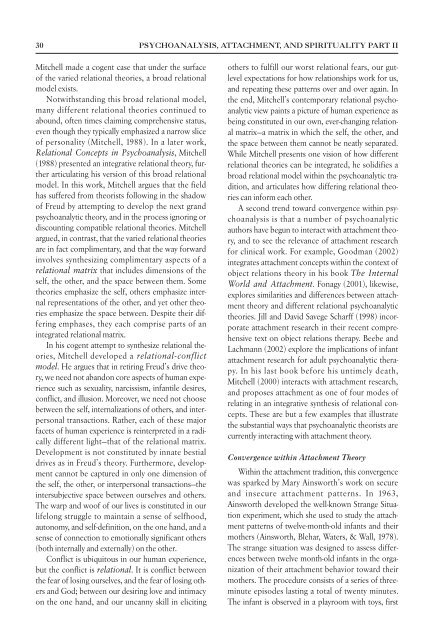

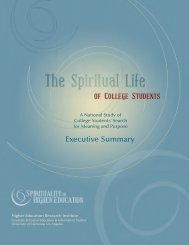
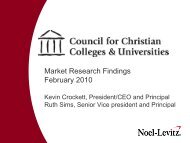


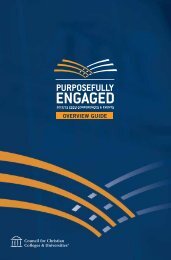


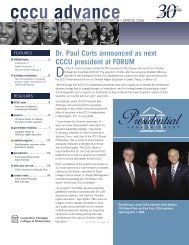
![Download Guide [PDF] - Council for Christian Colleges & Universities](https://img.yumpu.com/37211849/1/190x245/download-guide-pdf-council-for-christian-colleges-universities.jpg?quality=85)
